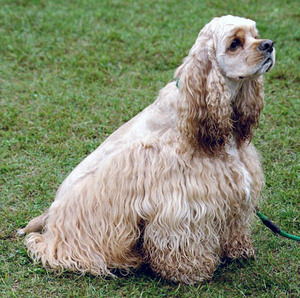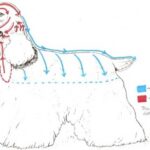I wasn’t near two years old, and, additionally, I was pretty uncoordinated at that. I remember sitting in a snow bank with the stereotypical “snowsuit” and boots and mittens. I couldn’t keep my balance but my parents kept propping me up giving themselves the illusion I was “playing” in the snow. What made the day even more miserable was that they had bought a dog for me; a Cocker Spaniel. In the Fifties the Cocker Spaniel was the pet to have (Remember Lady from “Lady and the Tramp”?) My parents were in a hurry to make me the “All-American Kid. All the puppy did was jump up in my face and try to lick me and play with me when I was incapable of play but not incapable of being terrified; my parents finally had to give the dog away.
The American Cocker Spaniel is actually a secondary breed. There are two Cocker Spaniel Breeds. Although both originated in Great Britain, the “American Cocker Spaniel” (or just Cocker Spaniel) is the one we typically think of and is distinguishable from the English Cocker Spaniel
The main breed traits of the Cocker Spaniel are that they are very friendly, loving, peppy, and affectionate. They love to play, hence my hands being full when I was about one and a half. How was the puppy to know I was just a human puppy? By the way, if you care, the dog was named “Taffy” which should give you an idea of its color.
Cocker Spaniels weigh about 28 pounds and are about 15 inches tall for the male. The female runs just about an inch shorter.
The colors of the breed run around the blacks and whites and browns, as well as some reddish or tan (or cream) color.
“…American Cocker Spaniels are susceptible to a variety of maladies, particularly infections affecting their ears and, in some cases, their eyes. As a result, they may require more medical attention than some other breeds. Common eye problems in Cockers include progressive retinal atrophy (PRA), glaucoma, and cataracts. The American Spaniel Club recommends annual eye exams by a veterinary ophthalmologist for all dogs used for breeding. Autoimmune problems in Cockers include autoimmune hemolytic anemia (AIHA) and ear inflammations. Less common are luxating patellas and hip dysplasia. Dogs used for breeding can be checked for both of these conditions, and dogs free of hip dysplasia can be certified by the Orthopedic Foundation for Animals (OFA)…” (Wilkipedia Cocker Spaniels)
After the Second World (synonomous with the Fifties); the Cocker spaniel was, indeed the most popular breed according to the registry of the American Kennel Club.
The Cocker Spaniel is making a tremendous comeback, not only as a pet, but getting increased respect as a “working dog” in the area of hunting; they are just having an overall resurgence.
If you are looking for a good pet, you won’t go wrong with a Cocker Spaniel (just don’t get your one-year-old a dog). The Cocker Spaniel may cost a little more to maintain, but, they are well worth it for what they bring to the table.






